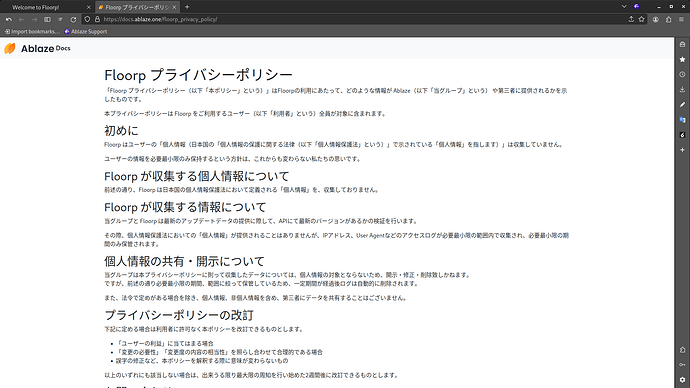I’m happy to see the Floorp Clan grow, but I am still amazed by the lack of an appimage for it
Does Floork does anything “better” than Librewolf?
Floorp is different than Librewolf.
- Librewolf is privacy focused, Floorp is not
- Librewolf is based Firefox, Floorp is based on Firefox ESR
- Floorp has added several quality of life features from a usability perspective
So it depends what you are looking for in a browser.
I use:
-
Librewolf (primary)
-
Ungoogled Chromium (backup)
@swh @anon26269396 @waterbuffalo @LDC
Do you guys use Floorp from the AUR or the Flathub?
Personally I tend to install the flatpak version of an app if there is an official release for it from the developers. I am just being curios which one you guys are using.
I think that makes sense considering the flatpak is containerized. Software such as a browser is a good idea to use in such fashion and as you outlined, if it’s an official release.
I used the AUR.
There are pros and cons. The con is that you have no idea what the bundled libraries included are. It is way too common for developers to bundle outdated or insecure software in the flatpak.(To be clear, this is not malicious) In most cases, I would rather use the system libraries.
I downloaded the Floorp release direct from github and unpacked it. So I can start Floorp directly from the directory
Ah, great! So you can just run the binary as a sort of “portable app”. Good to know!
Thanks for the info!
And what about the pros?
I have created a starter in the Kickoff Launcher that points to floorp in the unpacked directory. You can then update Floorp via the Help button–> About Floorp.
Thanks for the info!
You’re welcome!
Precisely why as @pebcak outlined, only with official verified flatpaks by the actual developers. If that wasn’t the case I wouldn’t even entertain the thought.
I have created a starter in the Kickoff Launcher that points to floorp in the unpacked directory. You can then update Floorp via the Help button–> About Floorp.
Sweet!
![]()
I guess I should be starting to brush up my 日本語 ![]()
I use the bin from the aur as it is updated once every few weeks it seems.
And what about the pros?
For me, personally, the pros vary by the specific application. The primary pro is that it may allow you to get access to software that would otherwise be difficult to install. For example, when I was recently testing different browsers, I installed some of them from flatpak because I didn’t want to build them from source for a brief test and they weren’t easily available in binary form.
Sandboxing is often discussed as a flatpak advantage but for my threat model, I don’t see much value in it. Especially for a general purpose browser. Flatpak sandboxing isn’t granular enough. The default permissions for the floorp flatpak give it access to…a lot. Of course, you can pare those permissions back but that will impact your ability to use the application in a convenient way. Unless it is a browser I am using for a very specific use case, I generally want it to have some access to my machine.
My feeling on flatpak sandboxing is that it isn’t very useful for me. If I have an application that really requires sandboxing, I would prefer to run it in a firejail, a dedicated container or VM where I have a lot more control.
only with official verified flatpaks by the actual developers
What I am talking about happens with “official verified flatpaks from the actual developers”. They may do a good job of taking care of their own software but it doesn’t mean they do a good job packaging everything else that is bundled into the flatpak. Being a good developer doesn’t inherently make you a good packager. That is the fundamental issue. A flatpak doesn’t only contain their software but also whatever needs to be bundled to make it work.
To be clear, I haven’t looked at this specific flatpak, that is more a general comment. I would much prefer the full transparency of an AUR package, personally.
That being said, I am not saying it is bad to run flatpaks. If you prefer flatpaks, that is great.
Librewolf is based Firefox, Floorp is based on Firefox ESR
Glad I read that part before I bothered trying it out. Pass.
Thanks @dalto for your insightful reply!
I appreciate it!
I would much prefer the full transparency of an AUR package, personally.
Please correct me if I am wrong, a PKGBUILD from AUR just describes how some binary is build from some source code and installed on your system.
In order to know what goes into that binary, doesn’t a user need to audit the code from the source?
If that is the case, for a code-uninitiated user, the transparency of AUR is true but with quite some modification.
I once created a profile with an Arkenfox user.js. I use Firefox Translations, Ublock Origin and libredirect as extensions. Feels good so far
As far as I have been able to determine so far, there are no issues.
If I want to change a profile, I have to go via about:profiles. The way via krunner with firefox -p in this case Floorp -p does not work. Maybe someone here knows more
Try floorp -P or floorp --profilemanager
Runnig it from terminal, works on my end.
